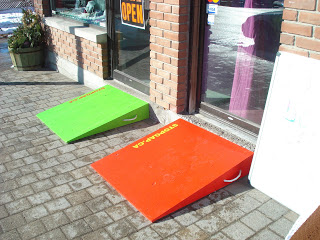DIY movement supplies accessibility ramps to Toronto businesses
A Toronto nonprofit is pioneering a do-it-yourself movement to make stepped entrances accessible throughout the city. So far, volunteers have constructed more than 400 brightly colored ramps in Toronto and other Canadian cities using donated materials and following guidelines offered by the nonprofit StopGap, reports CityLab.
Luke Anderson, StopGap’s co-founder, told CityLab that the project was born out of frustration. The Accessibility for Ontarians with Disabilities Act, which was passed nine years ago and was modeled after the Americans with Disabilities Act of 1990, gives businesses until 2025 to “implement the mandated provisions for built-environment accessibility.”
Anderson explains that his fix is a simple one, and one that shouldn’t be delayed: “Who wants to wait that long? The Ontario Human Rights Code prohibits discrimination based on disability and it trumps all other legislation,” he tells CityLab. “You could make a case against a business pretty easily, and I would support someone taking a legal approach. But I don’t want to put my energy into a battle for two, three, four, or five years when there’s something we can be doing right now.”
While customer service and communication accessibility standards have been required for almost 10 years, built-environment standards — such as accessibility ramps for wheelchairs — do not need to be implemented for 11 more years. Barrier-free design is only a requirement for extensive renovation or new construction.
The initial StopGap solution was first a for-profit, permanent ramp that Anderson and friend Michael Hopkins offered to store owners; that project failed, however, because of the cost associated with permanent ramps. But the current, portable version allows businesses to move the ramp and thus avoid the permit process required for permanent ramps. (The StopGap contract specifies that the ramp “should only be deployed when required,” but most ramps remain available all day, in part to signify the store’s accessibility.)
City officials have mixed reactions to the StopGap movement, speaking of the ramps “with a mix of praise and caution, caught between their practical ease and tangled legal issues connected to them. While they applaud the ready retrofit of storefronts to improve accessibility, all staff interviewed were clear that an ‘encroachment’ into public space requires a permit,” explains CityLab.
The city’s Right-of-Way Management department issues permits and fines, and manages what is permitted to be placed on sidewalks and streets. Right-of-Way manager Andre Filippetti wrote to CityLab in an email that “the fact that [the ramps] are removable is somewhat immaterial, as they could still be a trip hazard for someone, presenting a public safety and liability issue for the city.”
The city’s Disability Issues Committee called the project “innovative” in a report, but declined to include StopGap’s ramps in its accessibility plan, naming concerns like the “obstruction of ‘public pedestrian routes’ for people with ‘visual limitations,’ the risk of injury from lack of handrails, and the potential of the public to misperceive the ramps as AODA-compliant.” Another issue includes the potential inaccessibility of the inside of stores equipped with the ramps.
Yet the StopGap ramps aren’t intended to address every accessibility issue, just the dilemma of providing an entrance into stores with inaccessible steps. “I wouldn’t say that the ramps are a fix to the issue of inaccessible spaces,” says Anderson. “They certainly help with one small issue related to the built environment, but what they are doing is creating conversation and getting people thinking about permanent solutions to this huge design issue.”
Category: ADA














